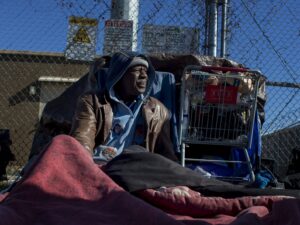 On a single night earlier this year, the Housing Forward 2024 Point-in-Time (PIT) Count found that 3,718 people in Dallas and Collin counties were experiencing homelessness. Each one has a name and a story. And many are also dealing with mental health challenges.
On a single night earlier this year, the Housing Forward 2024 Point-in-Time (PIT) Count found that 3,718 people in Dallas and Collin counties were experiencing homelessness. Each one has a name and a story. And many are also dealing with mental health challenges.
The Meadows Mental Health Policy Institute reports that 40% of adults experiencing homelessness in Dallas County live with a serious mental illness—eight times more than in the general population. In addition, 32% deal with a substance use disorder and 14% struggle with both a serious mental illness and substance abuse.
Experiencing homelessness greatly magnifies the challenges of living with a mental illness, and likewise mental health struggles often prevent people from obtaining safe, secure housing. This creates a compounding cycle that makes it difficult for individuals to address either issue. As the June 2023 report from the Task Force on Homelessness, Organizations, Policies, and Encampments (HOPE) explains, “lack of housing exacerbates any other issues an individual or family may be facing.”
A homeless person, as described in the McKinney-Vento Act, is an “individual who lacks a fixed, regular and adequate nighttime residence.” This definition also includes those who are staying in motels/hotels due to lack of adequate alternatives or sharing the housing of other persons due to loss of housing, economic hardship or another reason. A homeless person is also one who may be “living in cars, parks, public spaces, abandoned buildings, substandard housing, bus or train stations or similar settings.”
Here are four key things to know about homelessness in Dallas.
Lack of affordable housing is especially pressing in Dallas.
In Dallas, there simply isn’t enough affordable housing to go around.
While lack of low-income housing is a problem nationwide, it’s an especially pressing issue impacting homelessness in Dallas. According to the National Low Income Housing Coalition’s 2024 The Gap report, just 17 affordable and available housing units exist for every 100 low-income renter households—less than half of the national average of 34 available units.
Certain groups face a higher risk for homelessness.
While people from any demographic can experience homelessness, certain groups are more likely to be without stable housing. For some, race is a major risk factor: The PIT count revealed that Black households comprise 56.9% of the homeless population even though they make up just 19% of the general population in Dallas and Collin Counties. Many factors contribute to this risk, including systemic discrimination and the additional barriers minority populations face in accessing mental health care.
Gender can also put a person at higher risk. Approximately 64% of those experiencing homelessness were male.
It’s impacting children—and can affect them for a lifetime.
Homelessness in Dallas impacts not only adults but entire families. More than one in five households experiencing homelessness includes children. The PIT count also identified 130 unaccompanied homeless youth. Being without housing affects these young people in numerous ways that can impact them for a lifetime, including putting them at greater risk for serious health problems, behavioral and social issues, academic struggles and dropping out of school.
Efforts to decrease homelessness are helping.
While the PIT count contained sobering statistics, it also included signs of hope. It reports that since 2021, overall homeless has decreased by 19% and unsheltered homelessness has dropped by 24%.
The R.E.A.L. Time Rehousing Initiative, which began in October 2021, has played a significant role in these improvements. It has used federal funding and housing vouchers from the American Rescue Plan Act as well as private funding to provide housing, with a focus on helping the unsheltered homeless. Through it over 3,000 individuals have been housed.
Behind all of these statistics are real people living with the minute-by-minute challenges of homelessness—people like many members of the Well Community. Approximately half of those who participate at the Well’s Community Life Center are without housing, and for them the Well offers not only a respite from the elements, but a place where they belong and where they are surrounded by others who care. There, they enjoy hot meals, access resources and build friendships. In addition, through Jacob’s House, the Well’s City of Dallas licensed group home, the Well provides a safe, stable place to live for up to eight men dealing with serious mental health challenges.
You can help provide a place to belong for those with chronic mental health issues. Your gift can help subsidize rent for the men staying at Jacob’s House and offer nutritious meals to homeless members of the Well Community. Give now.
